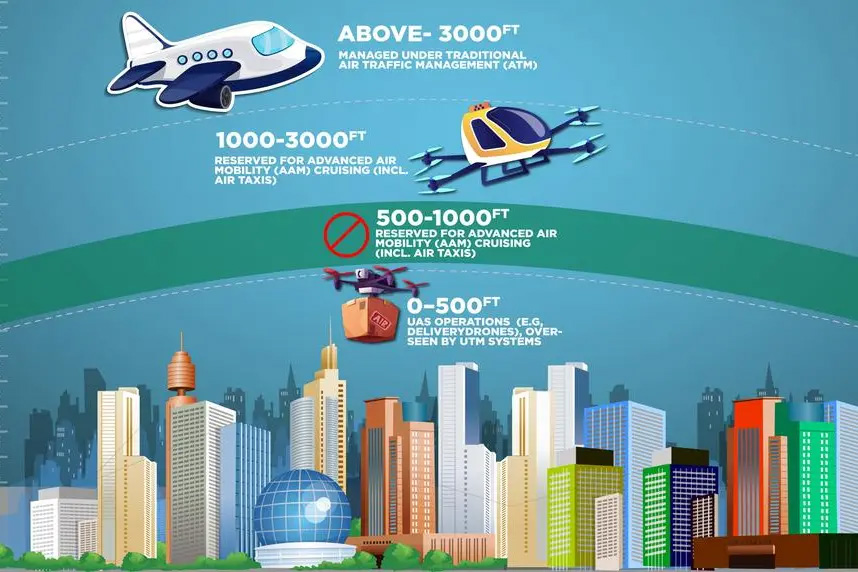The Technology Innovation Institute (TII) and ASPIRE, both subsidiaries of the Advanced Technology Research Council, in collaboration with the General Civil Aviation Authority (GCAA), are helping to position the UAE among the global pioneers in achieving an AAM regulatory framework, where TII will work on providing evidence-based recommendations to guide the development of Advanced Air Mobility (AAM) interfaces and solutions. This work is being overseen by the Smart and Autonomous Council, which plays a central role in guiding national efforts in autonomous systems and mobility.
While global interest in Advanced Air Mobility (AAM) is growing, few countries have introduced operational regulations or corridor simulation tools specific to autonomous air taxis. By launching simulation-driven trials across Abu Dhabi, the UAE is helping define the technical and regulatory standards for this next era of urban mobility.
TII is spearheading the UAE’s first simulation-based regulatory models for airspace corridors, with a focus on wind dynamics and flight safety boundaries. These models are foundational in informing data-driven regulation for both manned and autonomous aerial vehicles, ensuring orderly airspace management while minimizing ground risk. ASPIRE has played a central role in enabling the collaboration, supporting the broader ecosystem that underpins the safe and scalable deployment of autonomous air mobility.
Unlike conventional aviation regulations, the next generation of AAM requires new thinking around airspace design and use, particularly within dense urban environments. TII and GCAA are addressing this through four integrated workstreams: designing safe air corridors, setting aircraft separation standards, coordinating traditional and unmanned traffic systems, and advising on regulatory reforms to enable scalable integration for each maturity level of AAM.
Three pilot sites in Abu Dhabi – Yas Island, Zayed Port, and Abu Dhabi International Airport – are serving as testbeds for validating TII’s airspace configurations. These locations have been selected for their potential to serve as future vertiport and heliport hubs, offering real-world conditions for validating airspace configurations. The trials are underpinned by advanced simulation capabilities co-developed with the California Institute of Technology (Caltech), reinforcing the UAE’s scientific leadership in air mobility innovation.
Eng. Aqeel Al Zarooni, Assistant Director General for Aviation Safety Affairs at the GCAA, said: “As aviation continues to evolve, our regulatory frameworks must evolve with it. Through this collaboration with TII and ASPIRE, we are laying the groundwork for safe and scalable integration of next-generation air mobility. These trials mark a critical step in ensuring that both Air Traffic Management and UTM systems can operate harmoniously within UAE airspace, supporting our long-term vision for smart, connected cities.”
Dr. Najwa Aaraj, CEO of TII, said: ” Technology alone isn’t enough to unlock urban air mobility. It must be matched with forward-looking regulations that anticipate the complexities of autonomous flight. Through our collaboration with GCAA and ASPIRE, we’re helping define the global benchmarks for safe, intelligent airspace systems that will support piloted and autonomous air taxis alike.”
To support traffic deconfliction, a layered vertical airspace configuration is are being explored for future implementation:
- 0–500 feet: Drone Operations Zone – Managed by Unmanned Traffic Management (UTM) systems and designated for low-altitude Unmanned Aircraft System (UAS) operations, such as delivery drones, inspection drones, and other small unmanned aircraft.
- 500–1000 feet: Safety Buffer Zone – Kept clear for emergency responses or rerouting paths.
- 1000–3000 feet: Air Taxi Cruise Zone – Reserved for Advanced Air Mobility (AAM) cruising, such as larger, piloted or autonomous air taxis and passenger drones operating on fixed urban routes.
- Above 3000 feet: Commercial Aircraft Zone – Managed by traditional Air Traffic Management (ATM) systems, and used by commercial airliners, private aircraft, and other conventional aviation traffic.
This vertical layering is being tested and refined using simulations that analyze 3D wind flow around buildings and terrain – crucial for defining no-fly zones, safety buffers, and operational flight paths. The overall project spans a two-year timeframe, enabling robust analysis and phased regulatory validation.
Andrew Strefford, Executive Director at ASPIRE said:“Urban air mobility is not just about new technology; it’s also about trust and safety and so policy and regulation are critical for adoption. What we are cultivating in Abu Dhabi is a foundation for global trust in how future cities will connect and operate in their urban and suburban airspace to unlock untapped economic potential in their mobility and logistics sectors. When research, governance, and ambition align, technology becomes a true enabler of progress.”
This initiative directly supports GCAA in preparing regulatory conditions for piloted air taxis, with a forward-looking framework that can later extend to fully autonomous passenger and cargo flights across the city.
Dr. Enrico Natalizio, Chief Researcher, Autonomous Robotics Research Center at TII, said: “Simulating real-world conditions before deployment allows us to rigorously test airspace rules and urban air mobility scenarios at scale. This systems-level approach is ensuring our frameworks are not only safe and future-ready, but adaptable to the evolving needs of smart cities.”
The UAE’s regulatory groundwork, anchored by TII’s advanced modeling and enabled through ASPIRE’s ecosystem collaboration, lays the foundation for safe, scalable, and sustainable air mobility. This initiative reinforces Abu Dhabi’s position as a testbed for future-forward transport regulation, and a model for smart cities worldwide.




